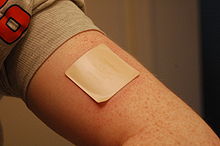Nicotine replacement therapy

The nicotine in cigarettes and other tobacco products makes people dependent. When they quit, they will get withdrawal symptoms. Nicotine replacement therapy (NRT) is there to reduce the dependency symptoms. This is usually done by delivering nicotine (or a substance very similar to it) in other ways. Common methods include nicotine patches and chewing gums with nicotine in them.
Cigarettes are responsible for the deaths of about 5 million people each year.[1] These people are not killed by the nicotine in the cigarette, but by other substances in tobacco smoke such as carbon monoxide and tars.
NRT delivers nicotine to the smoker's brain in a much slower way than cigarettes do. It helps to damp down the urges to smoke that most smokers have in the early days and weeks after quitting, rather than remove them totally. It gives the smoker the chance to break smoking cues in their daily lives, and might provide a more comfortable exit from the smoking habit. NRT however is best used with some form of support, ideally from someone who knows something about smoking cessation.
In 2005 the Committee on the Safety of Medicines recommended that NRT be given to pregnant smokers and to adolescent smokers.[source?]
Findings from a recent Cochrane review of controlled trials testing NRT products (Stead et al. 2008) showed that smokers using NRT were 1.5 to 2 times more likely to have stopped smoking at followup than those in the placebo or control treatment condition.
Criticism
[change | change source]Nicotine is the addictive drug in tobacco products so there is a chance when using NRT products to become addicted to those products. NRT products are safer then smoking tobacco. NRT products are generally expensive, sometimes even more so then cigarettes, so a minority of people may become addicted to the NRT product and turn back to tobacco products to save money.
Types
[change | change source]- Nicotine patch
- Nicotine gum
- Nicotine inhaler
- Nicotine lozenge
- Nicotine spray
- Nicotine sublingual tablet
Electronic cigarette
[change | change source]An electronic cigarette is an electronic item used instead of cigarettes. It gives a little nicotine, propylene glycol, and sometimes flavours, when you breathe through it. It was invented in China.
References
[change | change source]- Stead LF, Perera R, BullenC,Mant D, Lancaster T.Nicotine replacement therapy for smoking cessation. Cochrane Database of Systematic Reviews 2008, Issue 1. Art. No.: CD000146. DOI: 10.1002/14651858.CD000146.pub3.[1][permanent dead link]
- Silagy C, Lancaster T, Stead L, Mant D, Fowler G. Nicotine replacement therapy for smoking cessation. The Cochrane Database of Systematic Reviews 2004, Issue 3. Art. No.: CD000146.pub2. DOI: 10.1002/14651858.CD000146.pub2. abstract|full text[permanent dead link]
- Real-world efficacy of prescription and over-the-counter nicotine replacement therapy, by Shiffman S, et al., published May 2002 in Addiction, Issue 97(5) at Pages 505–516 Entrez PubMed
Other websites
[change | change source]- University of Wisconsin Center for Tobacco Research and Intervention Archived 2015-09-06 at the Wayback Machine
- Review of NRT from Cochrane Archived 2008-10-08 at the Wayback Machine
- The Best Electronic Cigarettes Archived 2018-06-30 at the Wayback Machine A complete guide on which electronic cigarette to buy
- Does CBD Help With Addictions Like Cigarettes Archived 2022-06-23 at the Wayback Machine Does CBD Help With Addictions Like Cigarettes? How it Reduces Cravings
